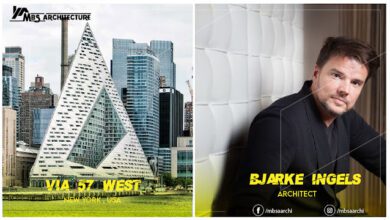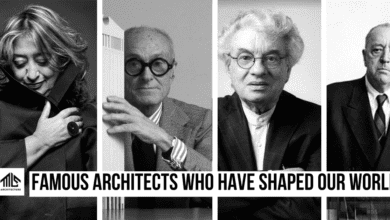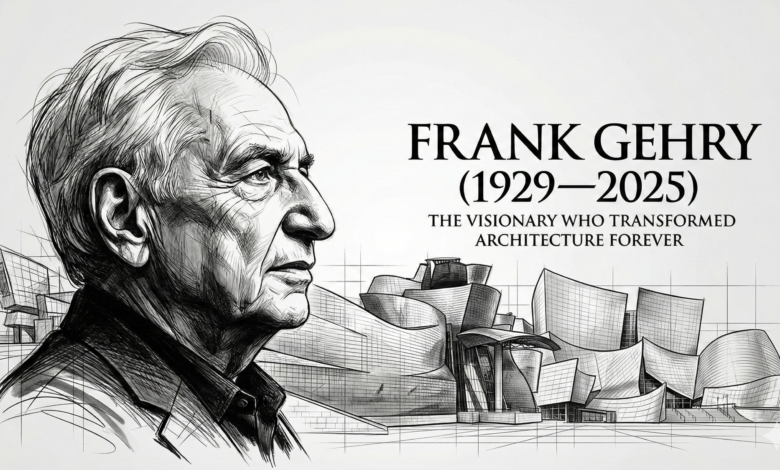
Frank Gehry (1929–2025): The Visionary Who Changed Architecture
Frank Gehry, the legendary architect who transformed the skylines of the modern world, passed away on December 5, 2025, at the age of 96.
For over seven decades, he defied the conventions of his field. He did not just practice architecture; he reinvented it. From the shimmering titanium curves of the Guggenheim Museum in Bilbao to the crumpled stainless steel of the Walt Disney Concert Hall, the Pritzker Prize winner proved that buildings could have the fluidity of a sketch and the soul of a sculpture. He leaves behind not just a catalog of iconic structures, but a fundamental shift in how we conceive, design, and construct the built environment.
In this comprehensive tribute, we analyze the life, the controversial process, and the immense technological legacy of Frank Gehry.
1. Early Life and Transformation
From Ephraim Goldberg to an Icon
The architect was not born into design royalty. He was born Ephraim Owen Goldberg on February 28, 1929, in Toronto, Canada. His childhood was modest; he spent hours playing with scraps of wood and metal shavings in his grandfather’s hardware store. This tactile experience would later manifest in the raw, industrial material choices that defined his signature style.
In 1947, his family immigrated to Los Angeles, where he drove a delivery truck while studying. In 1954, faced with pervasive racisme that hindered his career prospects, he made a difficult decision. At the suggestion of his first wife, he changed his surname from Goldberg to Gehry. He later admitted regretting the decision, stating that he “should have toughed it out.” However, this duality, the outsider trying to fit in while designing buildings that stood out, became a central theme of his life and work.
2. Design Philosophy: The Sketch is the Building
Chaotic Lines, Concrete Reality
Unlike many of his peers who start with a rigid grid, Frank Gehry started with a scribble. His design process is legendary in the architectural world. He was known for drawing “shambolic” sketches, chaotic lines that seemed to make no sense to the untrained eye. Yet, these sketches captured the energy and movement of the building before it existed.
“I search for the character of the building in the sketch.” , Frank Gehry
He did not trust computer renderings initially. Instead, his studio was a factory of physical models. He would crumple paper, cut velvet, and bend cardboard, creating hundreds of iterations to find the perfect form. This “hand-made” approach gave his buildings a human touch, even when executed on a massive scale. It was this refusal to accept the straight line that made his work instantly recognizable.
3. The Bilbao Effect: A Global Impact
How One Building Changed the World
To understand the magnitude of his impact, one must look at the Guggenheim Museum Bilbao (1997). Before this project, museums were often staid, quiet boxes. Gehry proposed a structure that looked like a ship running aground, or a fish jumping out of the water. Covered in 33,000 thin titanium plates, the building shimmered and changed color with the weather.
The risk was enormous. Titanium was expensive and hard to work with. However, the architect famously checked the market price and found a dip due to Russia dumping stock, allowing him to buy enough for the façade. The result was historic. The museum didn’t just house art; it was art. It attracted millions of tourists to a decaying industrial city, sparking an economic boom now studied by economists worldwide as “The Bilbao Effect.” This project cemented him as the most influential designer of his generation.
4. Frank Gehry and Technology (BIM)
Pioneering Parametric Design
For the readers of MBS Architecture, this is the most critical part of his legacy. Frank Gehry is the grandfather of modern parametric design, but out of necessity, not style. When he designed the Walt Disney Concert Hall, construction companies said, “This is unbuildable.” The complex curves couldn’t be described by traditional 2D plans.
He refused to compromise. He looked outside the construction industry and found CATIA, a software used by Dassault Systèmes to design fighter jets. He adapted this aerospace software to architecture, allowing for 0.1mm precision in bending steel beams. This innovation led to the founding of Gehry Technologies, which later became a standard-bearer for BIM (Building Information Modeling). Every time you use Revit or Rhino today, you are walking on the path he paved.
-
Read More: The Future of BIM in Architecture .
5. Major Projects and Innovations
A Tour of Iconic Works
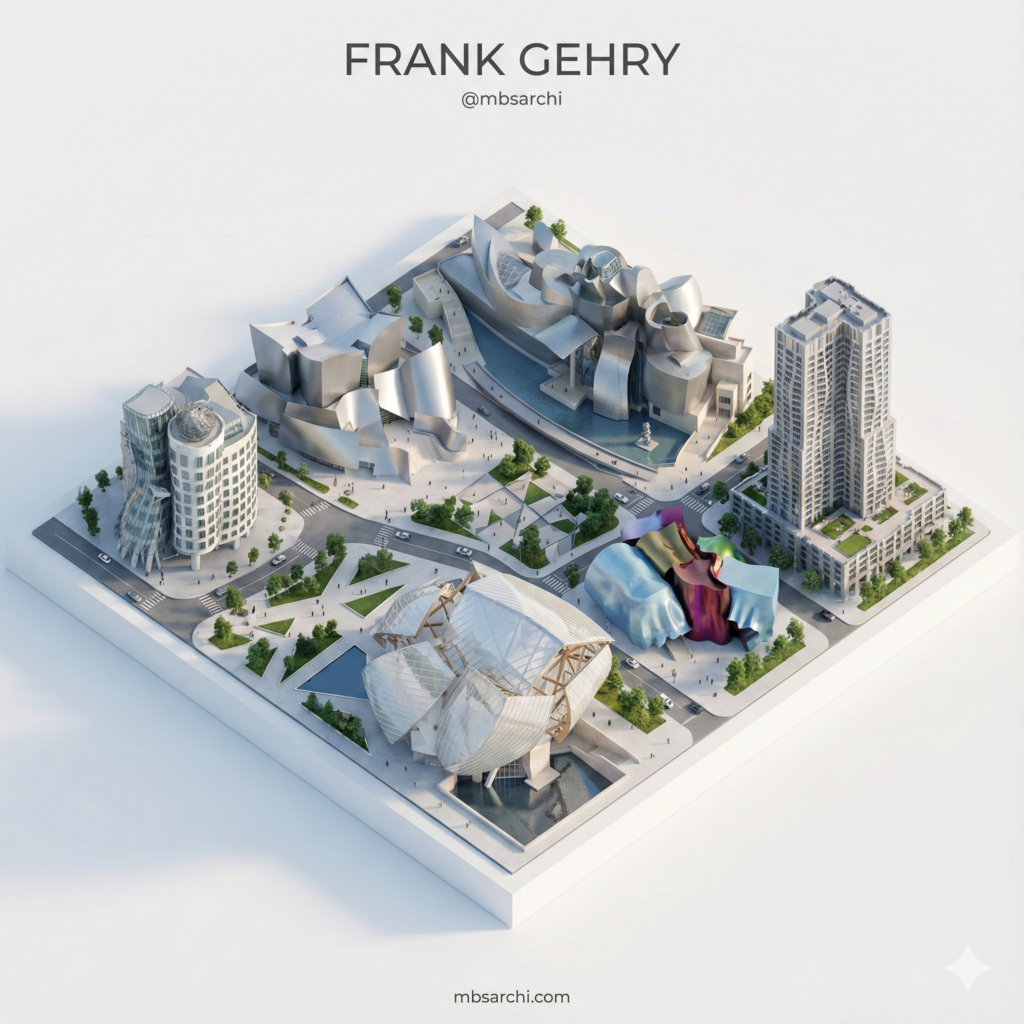
While Bilbao is the star, his portfolio is vast and varied. His ability to manipulate form allowed him to tackle diverse typologies.
- Walt Disney Concert Hall (Los Angeles, 2003): An acoustic masterpiece. The exterior stainless steel had to be sanded down because it was reflecting so much heat it was melting nearby traffic cones!
- 8 Spruce Street (New York, 2011): A residential skyscraper that looks like draped fabric made of steel, proving he could execute vertical density as well as sprawling museums.
- Fondation Louis Vuitton (Paris, 2014): A complex assembly of 12 glass sails. It required the development of new glass furnaces to create the curved panels.
- LUMA Arles (France, 2021): A twisting tower clad in aluminum tiles that captures the light of the Provence region, inspired by Van Gogh’s “Starry Night.”
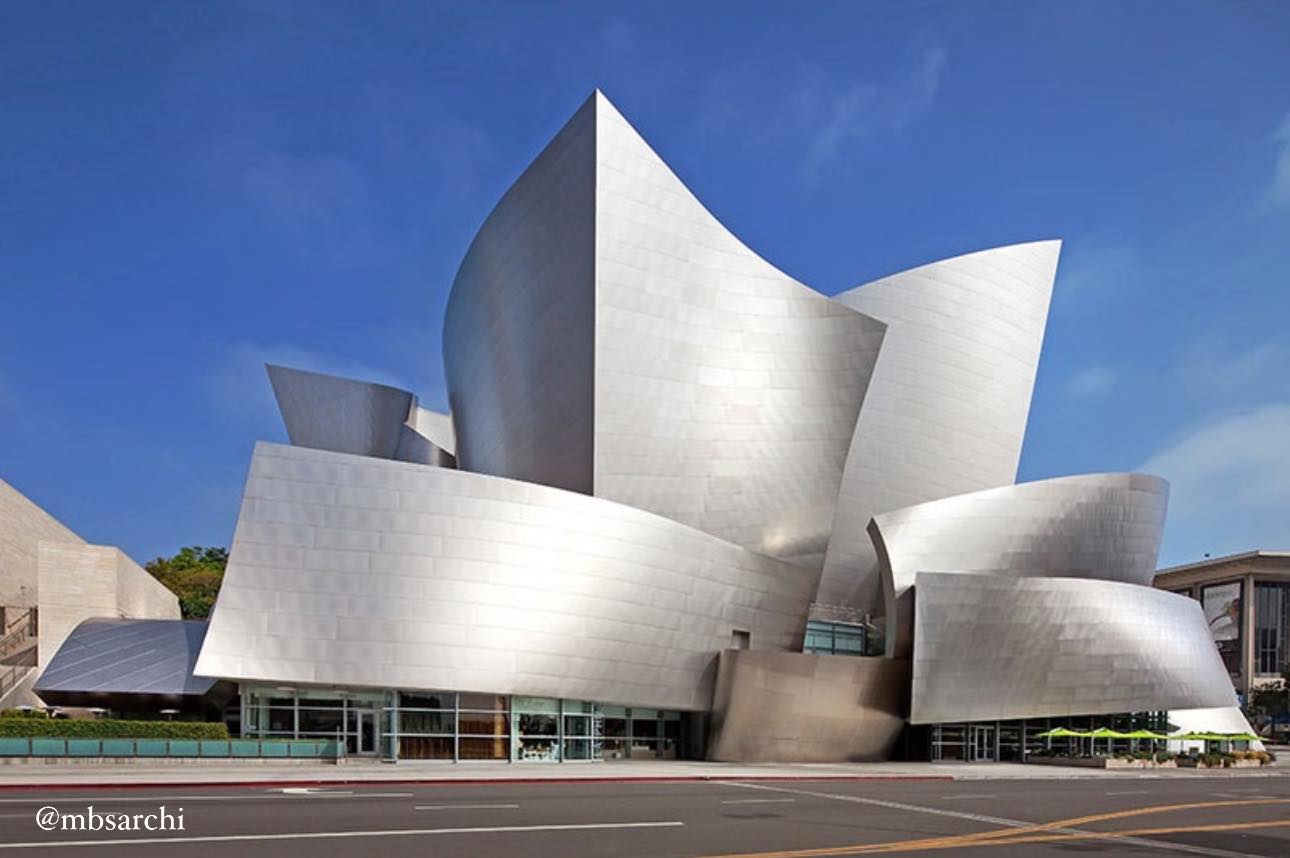
6. Critiques and Controversies
Function vs. Form
No tribute is honest without acknowledging the controversy. The architect had fierce critics throughout his career. Some argued that his obsession with form came at the expense of function. Residents of his buildings have occasionally complained about vertigo, leaks, or difficult-to-furnish rooms due to curved walls.
Others criticized the cost. His projects were notoriously expensive and complex to maintain. Critics labeled him a “Starchitect,” arguing his buildings were ego-trips that ignored the local context. However, he brushed these off, arguing that drab, soul-crushing boxes were a greater crime against humanity than a leaking roof. He believed architecture was for the spirit, and he remained unapologetic about his vision until the end.
7. Conclusion: An Enduring Legacy
The End of an Era
The death of Frank Gehry marks the end of the era of the “Hero Architect.” He was arguably the most famous architect in the world for three decades. He taught us that chain-link fencing could be beautiful. He taught us that a building could cry, dance, and sing. He took the cold, industrial materials of the 20th century and gave them the warmth of a human hand.
As we look at the twisted silhouette of the Dancing House in Prague or the shimmering shapes of his museums, we see the work of a man who never stopped playing with blocks. He changed the rules, and in doing so, he changed the world.


